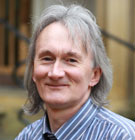Quantum communications and UK government policy
Researchers at York are influencing policy and funding decisions in quantum technologies and cybersecurity, at national and European levels.

[The government] identified AI and Data as a Grand Challenge to ensure we build on our world-leading reputation in harnessing new technologies, which we will achieve in quantum technology through continued collaboration between industry, government and the UK National Quantum Technologies Programme.
The issue
Keeping our information safe from interception, during transmission and in storage, is crucially important throughout society - from individuals and companies to institutions and governments. Data security is a major challenge for organisations handling highly sensitive information, such as hospital records and bank details, and is essential for online transactions.
Encoding data using the principles of quantum mechanics has the potential to provide absolute data security and safety from cyber-attacks. But for quantum technologies to become a reality, significant levels of funding are needed. To make a case for funding in this area, we require underpinning research for the practical implementation of future quantum technologies.
The research
A key focus for researchers at York is the development of Quantum Key Distribution (QKD).
QKD uses fundamental aspects of quantum physics to enable users to share data with one another. A transmitter sends very weak light signals – down at the quantum level – to a receiver, which measures them; these signals might be individual photons, or quanta of light, or other states of light which embody quantum features. As the transmitter knows what is sent and the receiver knows what is measured, a protocol – or system of rules – exists that both sides can adhere to.
This protocol enables both the transmitter and receiver to distil identical random data strings, or keys, from their transmission and measurement data. Quantum physics guarantees the security of these keys because any attempts to intercept information are immediately apparent.
Our research has made significant contributions to the fundamental understanding of how QKD can be implemented in practical systems, such as superconducting circuits, ion traps and molecular systems. Since optical fibres are the most promising candidates for transporting quantum information over long distances, our work on considering loss in such fibres and how it can be dealt with is also highly relevant to any practical implementation of QKD protocols.
The outcome
This research, and our advocacy, has had significant influence on government decisions, leading to increased investment into this strategically important area.
York research has informed policy debate and UK government decision making in this area; this led to over £300m being unlocked in support of the UK National Quantum Technologies Programme.
Our research has also impacted on the €1bn Quantum Technology Flagship launched by the European Commission in 2016. The launch of the flagship featured York's Professor Tim Spiller as an invited speaker, following his involvement in structuring the project.

Tim Spiller
Professor Spiller's research interests are in quantum information theory and the realisation of quantum information processing systems. He was lead author on the Quantum Communications chapter of the Blackett Review of Quantum Technologies.
